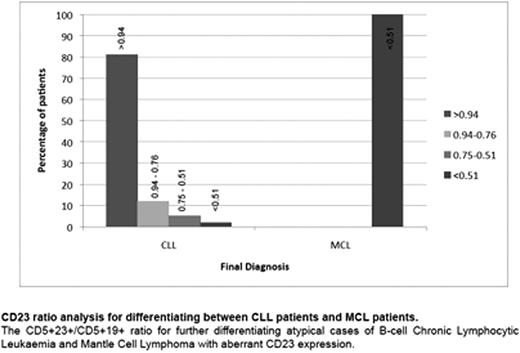Abstract
Abstract 4382
The diagnosis of many chronic B-cell lymphoproliferative disorders (B-LPD) is based on the integration of characteristic morphology, immunophenotype and cytogenetic analysis. Atypical B-cell chronic lymphocytic leukaemia (CLL), mantle cell lymphoma (MCL) and monoclonal B cell lymphocytosis (MBL) share many features. which can lead to diagnostic confusion.
Throughout the past decade, considerable progress has been achieved in defining new prognostic markers and treatment options in B-cell malignancies. However, over the same period, there has been only limited work performed on the diagnostic aspects of distinguishing CLL from other B-cell malignancies.
On a cohort of 748 consecutive B-LPDs, we established the three most robust diagnostic markers of CLL were CD5, CD23 and CD160. From this data set a 3-antigen 'mini' CLL score was derived, with each scoring one point. In this validation study, we compare the 'mini CLL score' against the 5-antigen Royal Marsden CLL score.
This validation study included 163 consecutive cases of B-cell malignancies (CLL n=113; CD5-negative B-LPD n=13; CD5-positive B-LPD n=10; MCL n=8; hairy cell leukaemia [HCL] variant n=5; HCL n=3; diffuse large B-cell lymphoma [DLBCL] n=3; splenic marginal zone lymphoma [SMZL] n=3; and lymphoplasmacytic lymphoma [LPC/WM] n=3; follicular lymphoma [FL] n=2). The prevalence of B-CLL in our validation group was 0.69 (0.61 – 0.76). Samples were analyzed using multicolour flow cytometry and sequential gating strategies. Same day analysis for all antigens was performed.
95% (107/113) of CLL cases were positive for the CD160 antigen (p=<0.0001). 7% of the confirmed CLL cases had an atypical phenotype and a Marsden CLL score of <3, suggestive of an alternative diagnosis to CLL. However, 75% (6/8) of these cases were CD160 positive.
Mini CLL score results by final diagnosis.
| . | 'mini CLL score' . | ||||
|---|---|---|---|---|---|
| 0 . | 1 . | 2 . | 3 . | TOTAL . | |
| CLL | 0 | 0 | 7 | 106 | 113 |
| MCL | 0 | 6 | 2 | 0 | 8 |
| HCL | 0 | 1 | 2 | 0 | 3 |
| SMZL/LPC/WM | 5 | 5 | 1 | 0 | 11 |
| Other BLPD | 7 | 15 | 6 | 0 | 28 |
| TOTAL 163 | |||||
| . | 'mini CLL score' . | ||||
|---|---|---|---|---|---|
| 0 . | 1 . | 2 . | 3 . | TOTAL . | |
| CLL | 0 | 0 | 7 | 106 | 113 |
| MCL | 0 | 6 | 2 | 0 | 8 |
| HCL | 0 | 1 | 2 | 0 | 3 |
| SMZL/LPC/WM | 5 | 5 | 1 | 0 | 11 |
| Other BLPD | 7 | 15 | 6 | 0 | 28 |
| TOTAL 163 | |||||
Global performance of the 5 point CLL Royal Marsden Scoring system against the 'mini CLL score'.
| . | CLL Score . | Mini CLL Score . |
|---|---|---|
| Sensitivity | 0.93 (0.87 - 0.97) | 0.92 (0.85 – 0.96) |
| False positive rate | 0 (0 – 0.07) | 0 (0 – 0.07) |
| Diagnostic odds ratio | ° (129 - °) | ° (116 - °) |
| . | CLL Score . | Mini CLL Score . |
|---|---|---|
| Sensitivity | 0.93 (0.87 - 0.97) | 0.92 (0.85 – 0.96) |
| False positive rate | 0 (0 – 0.07) | 0 (0 – 0.07) |
| Diagnostic odds ratio | ° (129 - °) | ° (116 - °) |
A mini CLL score of 3 was diagnostic of CLL and excluded all other B-cell malignancies (including MCL) in this cohort of 163 cases (p<0.0001). However, 7 CLL cases with a mini CLL score of 2 could not be distinguished from other B-cell malignancies, especially CD23+ MCL. This led to the approach of defining the ratio of CD23 to CD5 expression on malignant B-cells.
The CD23r proved of value with a ratio of >0.94 in 80% of patients (0.7104-0.8664), ie, a sensitivity and a specificity of 0.7965 and 1.000 (0.9598-1.000), respectively. A CD23r cut-off of 0.51 between the two diagnostic groups increased the sensitivity to 0.9912 (0.9517-0.9998) with an odds ratio of having CLL of 1275 (48.15-33765).
In summary, the near universal expression of CD160 in CLL allows a simplified and accurate immunophenotypic diagnosis of B-LPD. CD160 expression in CLL had a sensitivity and specificity of 0.9496 (0.8880-0.9803) and 0.8400 (0.7089-0.9283), respectively.
Despite the Royal Marsden Score and the new 'mini' score giving the same overall global performance (table 2), by combining the 'mini-score' with the CD23:CD5 ratio provides a complete discrimination between CLL and MCL, including cases of CD23+ MCL (p<0.0001). This study validates the previously reported expression of CD160 antigen in CLL and further justifies its use in the diagnosis of B-cell malignancies.
No relevant conflicts of interest to declare.
Author notes
Asterisk with author names denotes non-ASH members.


